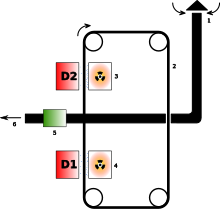Radiometric dust measurement
The radiometric measurement of dust is a method for the determination of airborne particles and dust emissions . The use of a beta emitter is necessary for this process . In the literature, suspended particulate matter measuring devices that work according to the principle of radiometric dust measurement are referred to as β-dust meters or beta-dust meters.
Process description
With the radiometric dust measurement , the dust-laden gas flow is passed through a filter by means of a compressor , whereby the dust is deposited on the filter. The impacted filter surface is then illuminated by a beta emitter and the radiation is recorded with a counter tube . The attenuation of the radiation compared to an unloaded filter surface is a measure for the separated dust. The average dust concentration can thus be determined from the recorded gas volume flow.
Radiometric dust measurement is used for both emission and immission measurements, the original area of application being immission measurement . In the case of immission measurements, compared to emission measurements, a longer period of time is usually required until a sufficiently large amount of dust has been collected on the filter surface. The minimum collection time for immission measurements is approximately one hour. The applied filters can be used for an elemental analysis after the measurement. Measuring devices that work on the principle of radiometric dust measurement can be used for automatically registering dust measurements.
The radiation sources are usually krypton-85 or carbon-14 . As the activity of the sources declines over time, absorption measurements are taken before and after the filter is applied and compared with one another.
Sources of error
Uneven dust distribution on the filter can lead to incorrect results, as can inhomogeneities in the filter, with filter inhomogeneities having greater effects. Similarly, radioactive dusts lead to erroneous results. In order to avoid measurement errors due to moist gases , the air that is drawn in is usually preheated.
In emission measurements, errors can occur due to the sampling geometry not being adapted to the measuring task.
literature
- Heinrich Dresia, Franz Spohr: Possible uses and errors of radiometric dust measurement for monitoring emissions, immission and workplaces. In: Dust - cleanliness. Air . 38, No. 11, 1978, ISSN 0949-8036 , pp. 431-435.
Individual evidence
- ^ A b Günter Baumbach: Air pollution control . Springer-Verlag Berlin, Heidelberg, New York, 2nd edition 1992, ISBN 3-540-55078-X , p. 220.
- ↑ Julius Bosch: Device for the continuous determination of the dust flow in gas flows. In: Dust - cleanliness. Air. 32, No. 11, 1972, ISSN 0949-8036 , pp. 436-440.
- ↑ Heinrich Dresia, Rolf Mucha: Registering, radiometric measuring device for the combined measurement of immissions and radioactivity in the air. In: Dust - cleanliness. Air. 34, No. 4, 1974, ISSN 0949-8036 , pp. 125-128.
- ^ A b Franz Joseph Dreyhaupt (Ed.): VDI-Lexikon Umwelttechnik. VDI-Verlag Düsseldorf 1994, ISBN 3-18-400891-6 , p. 1119.
- ↑ VDI 2463 sheet 5: 1987-12 measurement of particles; Measuring the mass concentration (immission); Filter process; Automated filter device FH 62 I (Particulate matter measurement; measurement of mass concentration in ambient air; filter method; automated filter device FH 62 I). VDI-Verlag, Düsseldorf, p. 5.
- ↑ VDI 2463 sheet 6: 1987-11 measurement of particles; Measuring the mass concentration (immission); Filter process; Automated filter device BETA-Staubmeter F 703 (Particulate matter measurement; measurement of mass concentration in ambient air; filter method; automated filter device BETA-Staubmeter F 703). VDI-Verlag, Düsseldorf, p. 5.
